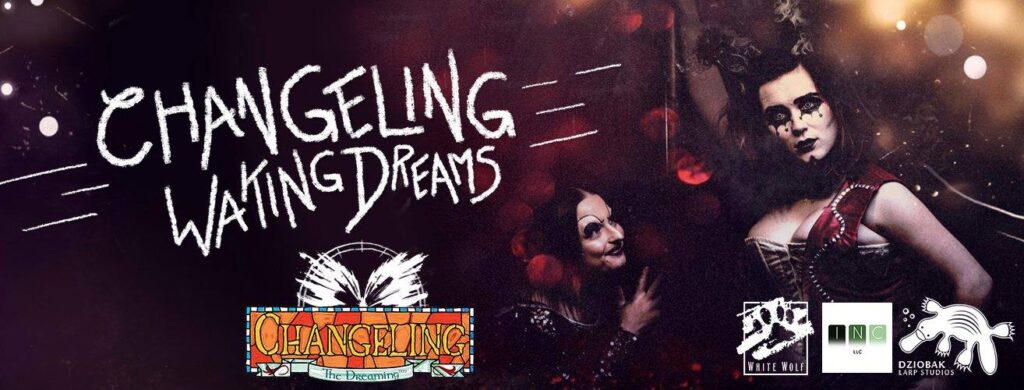In D. Vincent and Meguey Baker’s tabletop RPG Apocalypse World players are urged to let go of their control of the narrative and to “play to find out what happens,” an approach that is associative, collaborative, and oriented towards emergent play instead of a pre-existing plot or story-world into which characters are placed.1 When applied to larps this philosophy fosters a community where players are stakeholders in and co-creators of the diegetic world that emerges through play. These larps allow for an exploration of community and interconnection that supersedes the limits of their designers and organizers, though those explorations are always particular to the players that are involved. In this paper I examine ways to think about, create, and play these games that foregrounds the emergent experience and examines scholarly works that apply similar approaches. I believe that “playing to see what happens” is profoundly generative for the entire community, not just the players or the organizers, in a way that has the capacity to transcend the limits of the game. Playing this way can offer unique insights through personal reflection, and can offer a gaming community the agency and opportunity to decide who they want to be.
Narratives
Broadly speaking narratives in larps are on a spectrum between static “established” narratives and dynamic “emergent” narratives, though games can be designed for and understood to draw on elements from each. Established narratives have a story arc that is solely determined by a referee, game-master, or administrative team.2 These games often follow what narrative theorists James Phelan and Peter Rabinowitz identify as a “rhetorical model,” wherein the different elements all work together to provide a coherent linear structure.3 They have an internal logic that dictates how play proceeds, often follow a timeline that progresses from beginning to end, and emphasize the concepts laid out by the designers and/or facilitators. Deleuze and Guattari refer to this kind of structure as “arborescent” due to its focus on an operational core (a primary theme or plot) that branches into procreative and generative sub-systems (such as related subplots).4 The level of control exercised by the designers/facilitators supports an auteur mindset, wherein the strength and value of the experience is dependent on and credited to those same individuals.
Emergent narratives urge players to “play to find out what happens.”5 Though the contexts, characters, and situations encountered in a role-playing scenario may suggest a particular ending, that result is not a foregone conclusion. Furthermore the end of one scene may suggest the beginning of another scene that was not planned prior to the interaction. In other words, the way a narrative is “constructed and experienced cannot be predicted a priori.”6 In these narratives players are co-creators of the diegetic world, though players in a role-played scenario have more agency in that act than in literature or other non-reactive media where the co-creation exists entirely in the mind of the reader. While there are commonalities in the diegetic world, such as its setting or cultural understandings, a player’s experience of the game is highly individualized and determined by their own actions during the game. As Costikoyan (2002) notes, in a game the outcome “will differ depending on your decision. The game interacts with the players (and the players with each other), changing state as they play. […] That’s true of every game. If it isn’t interactive, it’s a puzzle, not a game.”7 Even ergodic literature, which is to say texts or games that ask a reader to make a decision, has a pre-planned response to the choices it offers.8 The complex web of elements and choices in an emergent role-playing game are defined by the multiple intersections in their relationships to one another rather than by a single generative point, and are best represented as a rhizomatic structure that results in broad emergent themes.

The interactive component of role-playing games will always inject an element of uncertainty9 whereas the structure of the rules and setting provide the common understandings that make play possible10 and frame concepts in a manner that we can understand.11 There is a tension that exists between the plans of designers and organizers and the inevitable chaos of play (at least in live-action games), or between established and emergent narratives, that Eirik Fatland identified as the “fog of larp”. Fatland suggests designers conceive “integrative” and “dissipative” techniques in an effort to create different experiences of play.12
| COMMON EXPECTATIONS | |
| Established Narrative |
|
| Emergent Narrative |
|
Rhizomatic Epistemology
In order to break down and examine the way that emergent larps function I designed a rhizomatic epistemology. It combines Actor-Network Theory, also known as ANT, with rhizomatic thought as described by Gilles Deleuze and Felix Guattari.13 In ANT, entities are defined by their relationships to one another and perform their identity “in, by, and through those relations.”14 The result of that approach is an illusory, but descriptive, snap-shot of a given point in space and time, such as how a larp’s characters, players, and contexts are connected.15

In Rafael Bienia’s ANT analysis of RPGs he prioritizes a shift from an anthropocentric perspective (narrowly focused on human agency) into one that also looks at how material objects “shape, constrain, and evoke RPG phenomena”16 where material objects are considered to have as much agency as humans to affect change. I integrated “rhizomes,”17 lines of connection of connection that overlap and inter-penetrate to create an “assemblage” of relationships, because ANT focuses on observing and describing only what is observed in the present tense and is not well-suited to seeing where relationships come from or might lead. As in ANT, elements become visible when they intersect,18 but rhizomatic thought allows for intangible elements, such as themes, thoughts, or emotions, to create a “map” that allows for growth and change.19
The resulting epistemology highlights the relationships between the various actors in play by framing them in different moments. It may include the characters, costumes, and props, but also incorporates non-diegetic details that affect play, such as emergent themes, current events in the players lives, the real-world interruptions of diegetic spaces, and the development of relationships after a game has ostensibly ended. There is a quality of inaccuracy to rhizomatic thought that can give a more honest accounting of an experience because it isn’t constrained by linear understanding. Some researchers use an epistemology that favors working with the elements described above as “established narratives”, generally focusing on the rules, media produced by organizers, and“in-character” portions of play. This is because the multiplicity of texts that exist for each player create a level of complexity that can muddy understanding of the game as a whole (from an arborescent perspective) and a focus on the game as a collection of literature rather than as a collection of experiences.20 Because of its focus on role-playing as a collection of interconnected experiences, a rhizomatic epistemological model has a different purpose and focus and will therefore garner different results. As in arts-based research, it seeks “to describe, explore, or discover”21 the experiences it examines, and “to awaken, to disclose the ordinarily unseen, unheard, and unexpected.”22 While clarity is certainly desirable, the primary goal of my model is to “apprehend rather than represent the world” by driving towards a sense of what a game is like for participants rather than describing its plot or rule sets.23
A rhizomatic epistemology takes into consideration what Mike Pohjola calls inter-immersion, wherein the shared reality of the game is created “from the collective experience of immersion shared and strengthened through interaction.”24 These interactions are between all elements of play, not just those between players, and thus lend themselves to descriptions of understandable networks of ANT and the rhizomatic interactions that emerge within that network. Furthermore, this approach makes space for experiences that preceded or followed “game-time,” which augments its reflective capacity and presents a format for how we understand works that attempt to anticipate change like Stuart Candy and Jake Dunagan’s “experiential futures.”25 Superimposing these past, present, and futures enables a researcher to engage in double-looking, a form of meta-thinking described by arts education scholars jan jagodzinski and Jason Wallin where thoughts about perception occur simultaneously with the act of perception26 and produce an “extension of what might be thought.”27
Examples
I have chosen three examples from colleagues that describe their experiences with emergent narratives. The descriptions include the author’s own reflections through the lens of the rhizomatic epistemology described above to highlight opportunities players found in exploring theories, self-assessment, re-contextualizing social dynamics, and in fueling their creativity.
In Teaching Gramsci and Arendt at Wizard School (2016) Evan Torner uses his experience larping as a teacher of ethics at the New World Magischola college of magic to reflect on the invisible neo-liberal concepts that govern us and resist rebellion, particularly in a higher education setting.28 To achieve this he approaches the experience as a multidimensional fantasy, and explodes his actions and choices outward to see how they connected different aspects of his life across time, which highlights ideas that would normally remain intangible and invisible when viewed in isolation.

In his reflection Torner discusses how the theme of inclusion reflects the deliberate design choices Maury Brown and Ben Morrow made to build empathy and empower others, striving towards an atmosphere of trust that “afforded the players to take appropriate risks.” This environment coexists with Torner’s other larp experiences, but also with his time on various college campuses as a student and a teacher and his scholarly research into ethical concepts. His character began with the question “What if Robert Smith from The Cure was my fashion template?”, and his partner Kat Jones helped him develop the visual aesthetic to represent that. The iconoclastic personality of the character was fleshed out by elements of Torner’s former professors and of the people he had studied. Because he had experienced being an “outsider” who had no real connections in prior larps, Torner decided to seek out connections before the game began. As a real life professor and game designer he says that he wanted to “teach the players something that I myself was actually an expert in, so that they could then feel like they as characters had also learned something.” His character even put on a rock concert, accomplished through the magic of lip-sync and air guitar, that mirrored some of the experiences he and Kat Jones worked into their rock and roll larp, Slayer Cake.
Torner’s preparation, play, and reflection in this piece share connections with his experiences as a scholar, gamer, teacher, and fan of music. These elements exist interdependently, as a multiplicity29 that combines reality, representation, and subjectivity. The resulting assemblage he presents gather and frame these connections in a manner that is understandable and productive, a frozen moment of complexity, even while the connections themselves remain mutable as time passes. Thus even while Torner feels that his character didn’t experience much change during the game, he says that he was able to use his play experience to examine his connections with the world around him.30
In The Battle of Primrose Park: Playing for Emancipatory Bleed in Fortune & Felicity (2017), Jonaya Kemper describes how her experience in the Jane Austen-themed Fortune & Felicity larp integrated her love of larping, an homage to literature that she adores, and her need to do field work that supports her academic pursuits.31 Her work is specifically focused on autoethnographic accounts of emancipatory bleed, which she says is “the idea that bleed can be steered and used for emancipatory purposes by players who live with complex marginalizations.” Her approach contrasts her own identity as a contemporary young woman of color and her character’s identity as a Georgian era impoverished white widow with two children in need of spouses, as well as in the discordant understandings between the organizers of the larp and Kemper about what each of those identities meant.
Kemper’s treatise unites a collection of social objects32 to create a complex, yet understandable, map of her experience. The process for creation, collection, and representation of these objects was planned in advance. As Kemper describes it:
“Before attending, I would create a playlist of songs to build ideas about the character, create a costume that was heavily tied to the character, and keep diaries to form a thought process that was unique to the character, fleshing out their mental space and state. During the game, I would keep thorough diaries from the character’s perspective, retain ephemera collected — letters given, tokens found etc. — and steer towards those themes from which I wanted to receive bleed while trying to be as deeply immersed as possible. Afterwards, I would complete a thorough living document including visuals and catalogue the physical objects to be later used in a final thesis exhibit.”
The result is a reflection that is both multi-modal in its artifacts and asynchronous to the playing of the game itself, which juxtaposes “real” elements of play against those that were “imagined” during in-character portions. This juxtaposition is key to her exploration of W. E. B. Du Bois’ double consciousness, where she sees the weight of history and culture through her own eyes and through the eyes of others. In this sense, when her character changed from an impoverished widow into the hero of her own story it was more than a satisfying play experience, but also an inspiration for a scholar to redefine herself in the face of systemic oppression. This was both a result of the emergent narrative and of the efforts she shared with other players to steer the game off the oppressive rails the designers had unintentionally laid down, working as a multiplicity to transform the community that they were a part of.
In The Art of Larp, Sharang Biswas talks about larp as a communal and participatory art form, and refers to his experiences playing and creating artworks in Changeling: Waking Dreams as a glam-rock faerie and as Alan Ginsberg in Beat Generation. In addition to noting my own observations on the importance of objects in New World Magischola,33 he explains “To LARP is to embody stories. To LARP is to forge connections with others. To LARP is to transfigure mundane place into sacred space, magic circles where art can and should be created, consumed and appreciated, and done so freely, communally and prolifically.”34

This pursuit of art in larp and larp as art is a synthesis of two elements. Firstly is the creative efforts of the players themselves. Biswas quotes Hannah Arandt in The Human Condition as saying “In order to become worldly things, that is, deeds and facts and events and patterns of thoughts or ideas, they must first be seen, heard and remembered and then transformed, reified as it were, into things – into sayings of poetry, the written page or the printed book, into paintings or sculpture, into all sorts of records, documents and monuments.” When a larp gives players a space to create art as a part of play, the imagined space that it occupies makes it more possible for them to take the risk of creating a thing that supersedes the limitations of the design. As James Hans states “…play of the natural world preceded the play of language and indeed, generated it, so we must assume that there is more to human play than language.”35
The second aspect, which is charted most effectively through a rhizomatic epistemology, is the role the community plays in the creative efforts. Regardless of the skill level of the artist, characters react with enthusiasm and respect that often bleeds into player perceptions as well, Pohjola’s “inter-immersion”36 made manifest in play and in artifact. Here again we see the value of the multiplicity, which in larp includes a population made up of players and characters occupying a space that crosses through realities and times. Every member of this multiplicity understands and interacts with it differently, even while their inclusion is part of what defines the whole.37
Conclusion
While role-playing experiences can be constructed and understood as only structured narratives, the descriptive qualities of emergent play are more likely to highlight what a game means to the people who played in them. This is because it is particular to the players, incorporates non-linguistic data, and supersedes limitations on time and space, which uncouples the meaning from the predetermined plot and situates it in the shared experience of the community of play. The rhizomatic epistemology cedes that it is only looking at a part of that experience, but it understands that part in relation to the whole. That experience and the ideas it generates are unpredictable and localized to players, and that is exactly why they are valuable. They are more than data sets and stories, they are works of art that represent aspects of both the collective and the individual, and they have art’s ability to inspire and grow new works in return.
We larp to explore the unknown, whether that is what stories we can create, how we think of ourselves, what beliefs we hold, or how we want to shape our world. That communities that are at the forefront of that exploration are empowered by games that recognize members as collaborators and who are open to the emergent realities, ludic and otherwise, that a rhizomatic approach to game design supports. The potential results of that play are a thing that (delightfully) cannot yet be known, but I for one am eager to play to find out.
–
Featured Image is “Mahonia sp.” by Linda De Volder @Flickr CC BY-NC-ND.
–
Jason Cox…

